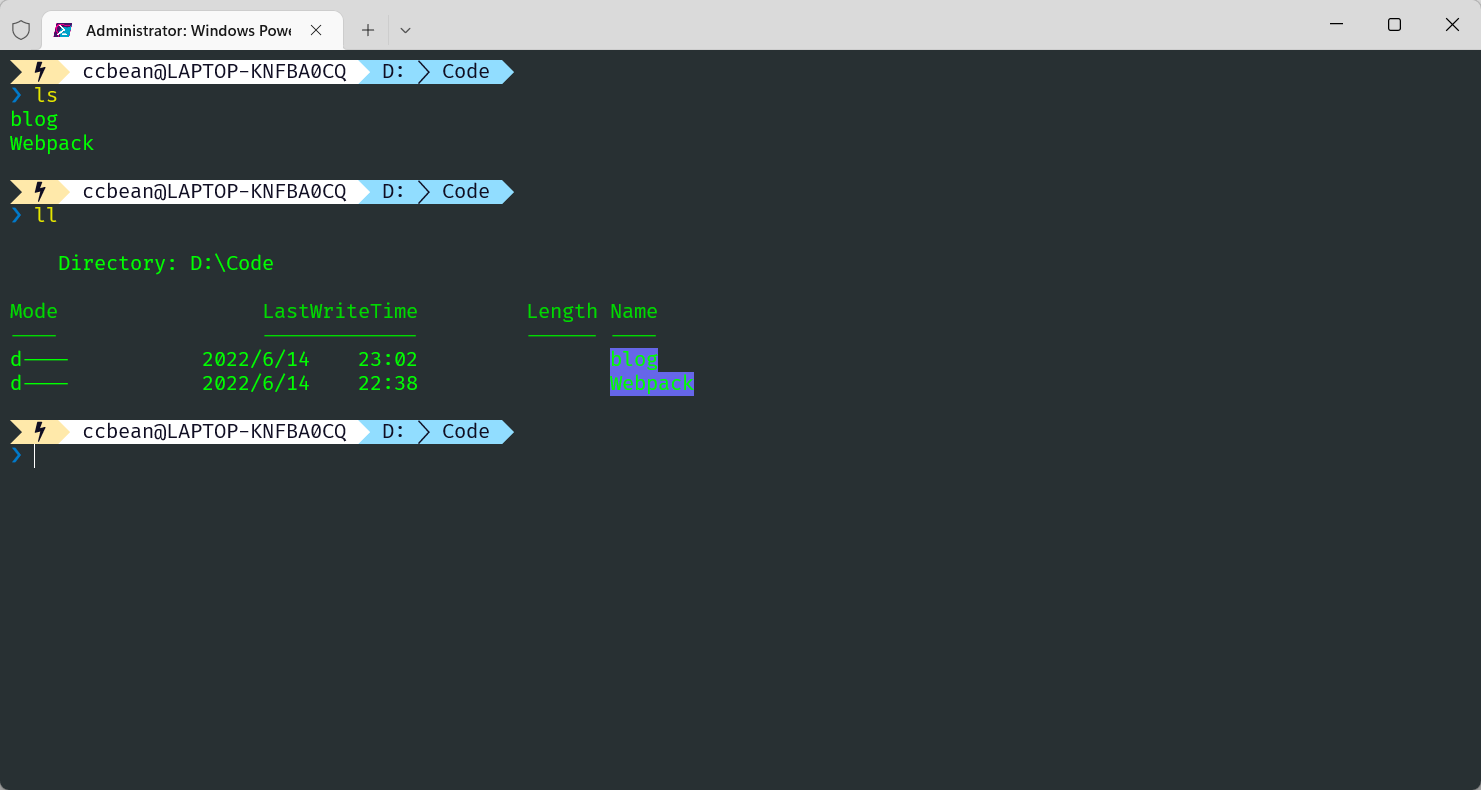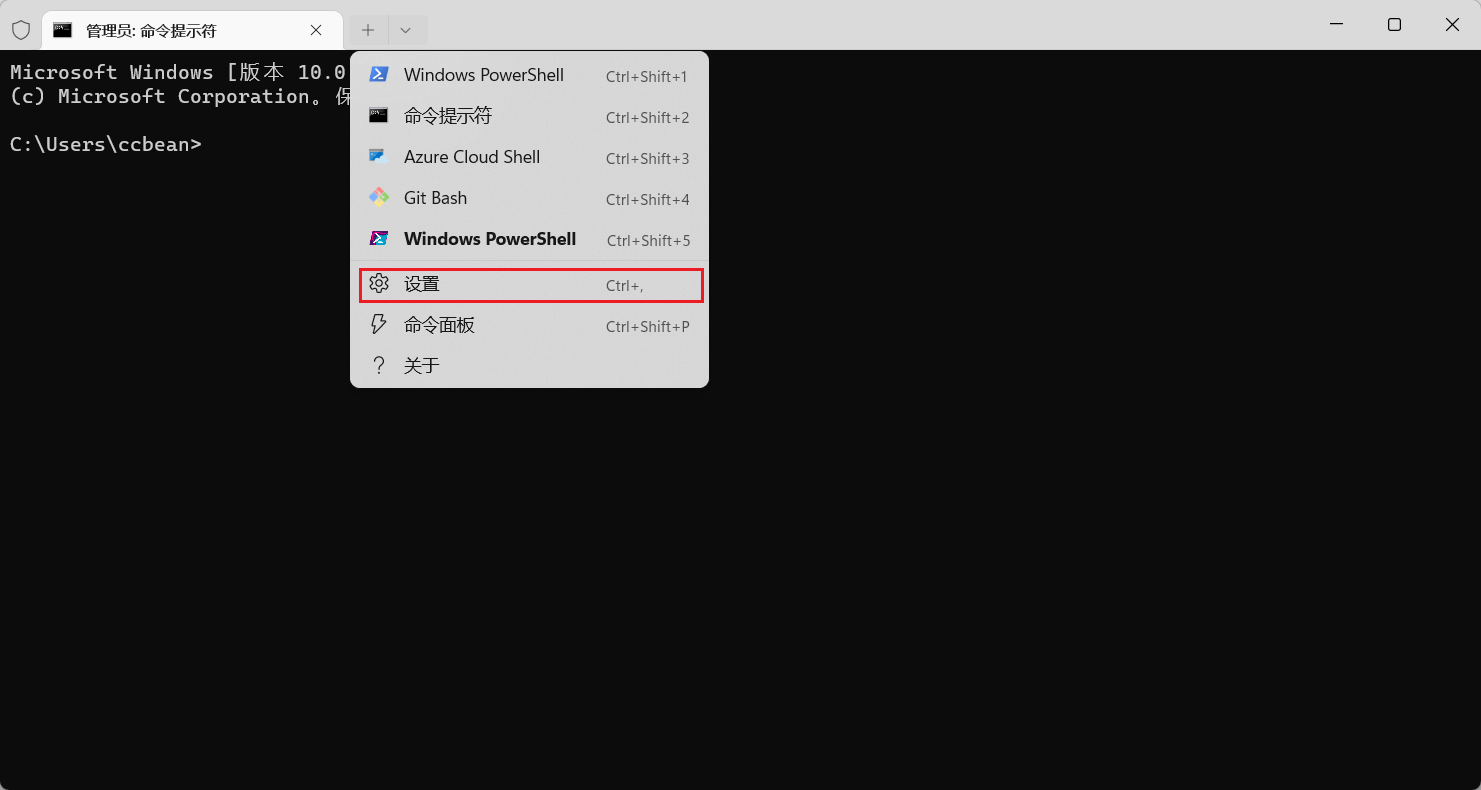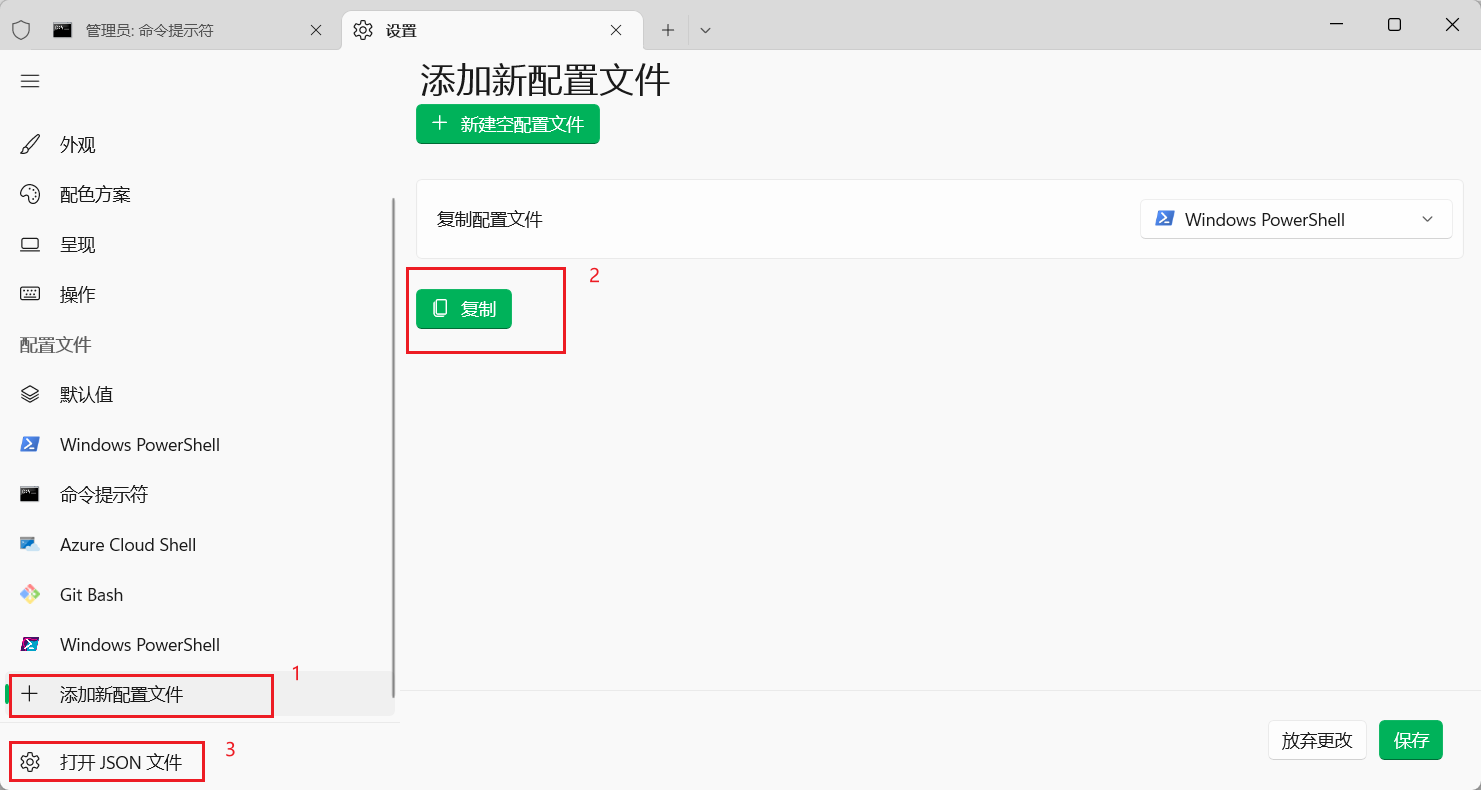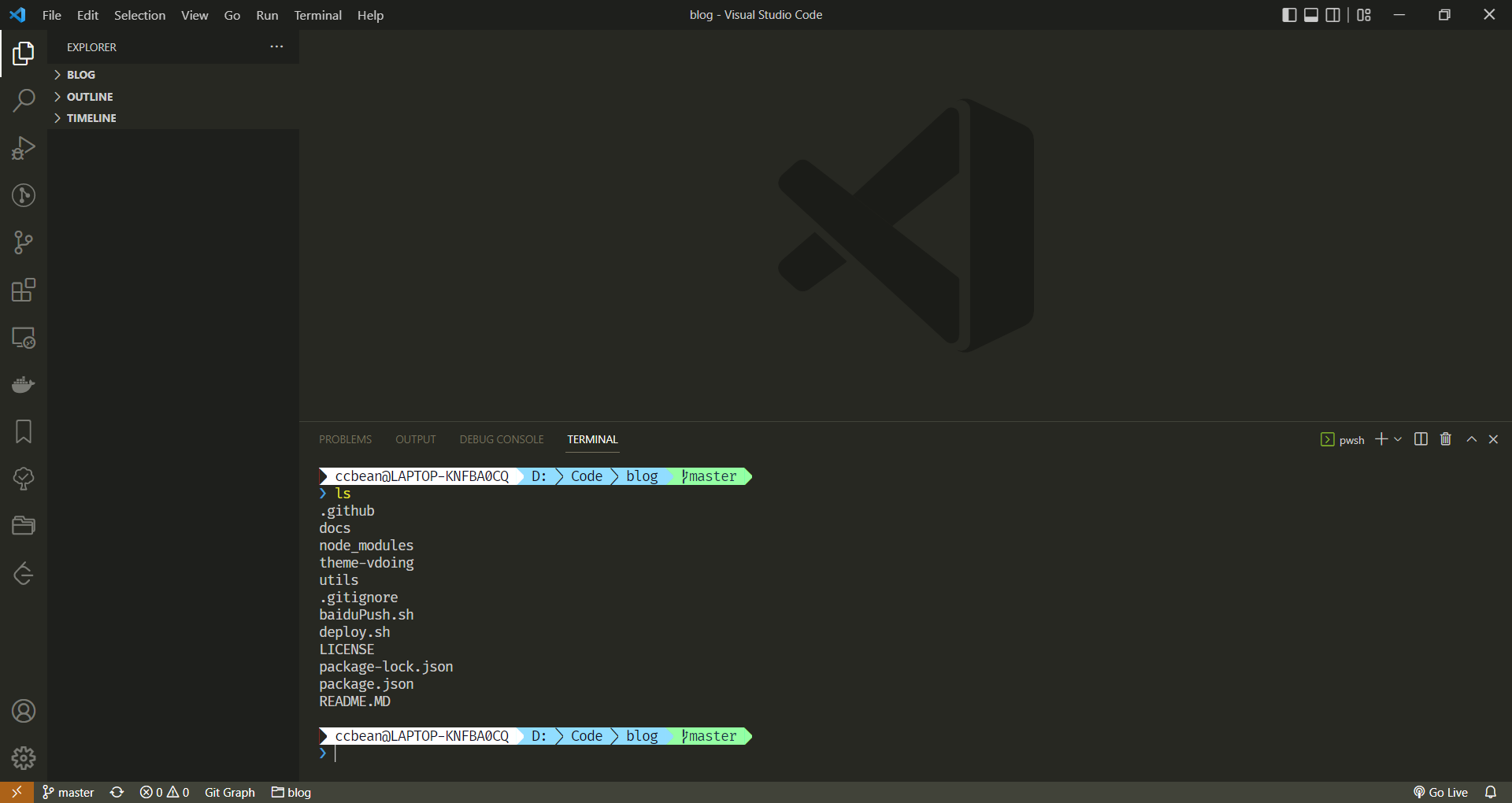 配置WindowsTerminal
配置WindowsTerminal
# 配置Windows Terminal
效果如下:

步骤如下:
- 安装Windows Termial
- 安装新PowerShell,即新版Powershell
- 安装新PowerShell插件,并配置脚本,优化新Powershell使用体验
- Windows Termial中配置新PowerShell
- 安装oh-my-posh和Nerd Font优化新PowerShell主题,让命令行变得更加炫酷优雅
- 配置VSCode中使用新PowerShell
# 安装Windows Terminal
Microsoft Store中搜索Windows Terminal,然后点击安装。
或点击此链接Windows Terminal (opens new window)获取
# 安装新Powershell
Powershell Core与 Windows 自带的 Powershell的升级版。
自带的 Powershell 错误提示冗长,颜值低,速度慢。
打开Windows自带的Powershell会看到如下提示:
Windows PowerShell
版权所有 (C) Microsoft Corporation。保留所有权利。
尝试新的跨平台 PowerShell https://aka.ms/pscore6
尝试新的跨平台PowerShell就是我们要安装的Powershell Core,可以去官方文档 (opens new window)中下载安装包进行安装。
不过官网中可能不是最新的,可以从Github仓库的Powershell (opens new window)中下载最新的Powershell的msi安装包。
目前安装版本是:v7.3.0-preview.4 Release of PowerShell (opens new window)
# 安装新PowerShell插件
以管理员模式运行刚安装好的新Powershell
执行脚本安装如下插件:
# 1. 安装 PSReadline 包,该插件可以让命令行很好用,类似 zsh
Install-Module -Name PSReadLine -Scope CurrentUser -Verbose
# 2. 安装 posh-git 包,让 git 更好用
Install-Module posh-git -Scope CurrentUser
安装时系统会提问是否继续,直接输入 A 并回车即可。
在PowerShellCore中执行:
# 使用了VSCode
code $profile
注:这会在用户的文档目录下生成一个PowerShell脚本:C:\Users\%USERNAME%\Documents\PowerShell\Microsoft.PowerShell_profile.ps1
粘贴如下脚本并保存:
#------------------------------- Import Modules BEGIN -------------------------------
# 引入 posh-git
Import-Module posh-git
# 引入 ps-read-line
Import-Module PSReadLine
#------------------------------- Import Modules END -------------------------------
#------------------------------- Set Hot-keys BEGIN -------------------------------
# 设置预测文本来源为历史记录
Set-PSReadLineOption -PredictionSource History
# 每次回溯输入历史,光标定位于输入内容末尾
Set-PSReadLineOption -HistorySearchCursorMovesToEnd
# 设置 Tab 为菜单补全和 Intellisense
Set-PSReadLineKeyHandler -Key "Tab" -Function MenuComplete
# 设置 Ctrl+d 为退出 PowerShell
Set-PSReadlineKeyHandler -Key "Ctrl+d" -Function ViExit
# 设置 Ctrl+z 为撤销
Set-PSReadLineKeyHandler -Key "Ctrl+z" -Function Undo
# 设置向上键为后向搜索历史记录
Set-PSReadLineKeyHandler -Key UpArrow -Function HistorySearchBackward
# 设置向下键为前向搜索历史纪录
Set-PSReadLineKeyHandler -Key DownArrow -Function HistorySearchForward
#------------------------------- Set Hot-keys END -------------------------------
#------------------------------- Functions BEGIN -------------------------------
# Python 直接执行
$env:PATHEXT += ";.py"
# 更新系统组件
function Update-Packages {
# update pip
Write-Host "Step 1: 更新 pip" -ForegroundColor Magenta -BackgroundColor Cyan
$a = pip list --outdated
$num_package = $a.Length - 2
for ($i = 0; $i -lt $num_package; $i++) {
$tmp = ($a[2 + $i].Split(" "))[0]
pip install -U $tmp
}
# update TeX Live
$CurrentYear = Get-Date -Format yyyy
Write-Host "Step 2: 更新 TeX Live" $CurrentYear -ForegroundColor Magenta -BackgroundColor Cyan
tlmgr update --self
tlmgr update --all
# update Chocolotey
Write-Host "Step 3: 更新 Chocolatey" -ForegroundColor Magenta -BackgroundColor Cyan
choco outdated
}
#------------------------------- Functions END -------------------------------
#------------------------------- Set Alias BEGIN -------------------------------
# 1. 编译函数 make
function MakeThings {
nmake.exe $args -nologo
}
Set-Alias -Name make -Value MakeThings
# 2. 更新系统 os-update
Set-Alias -Name os-update -Value Update-Packages
# 3. 查看目录 ls & ll
function ListDirectory {
(Get-ChildItem).Name
Write-Host("")
}
Set-Alias -Name ls -Value ListDirectory
Set-Alias -Name ll -Value Get-ChildItem
# 4. 打开当前工作目录
function OpenCurrentFolder {
param
(
# 输入要打开的路径
# 用法示例:open C:\
# 默认路径:当前工作文件夹
$Path = '.'
)
Invoke-Item $Path
}
Set-Alias -Name open -Value OpenCurrentFolder
function Test {
nmake.exe $args -nologo
}
#------------------------------- Set Alias END -------------------------------
#------------------------------- Set Network BEGIN -------------------------------
# 1. 获取所有 Network Interface
function Get-AllNic {
Get-NetAdapter | Sort-Object -Property MacAddress
}
Set-Alias -Name getnic -Value Get-AllNic
# 2. 获取 IPv4 关键路由
function Get-IPv4Routes {
Get-NetRoute -AddressFamily IPv4 | Where-Object -FilterScript {$_.NextHop -ne '0.0.0.0'}
}
Set-Alias -Name getip -Value Get-IPv4Routes
# 3. 获取 IPv6 关键路由
function Get-IPv6Routes {
Get-NetRoute -AddressFamily IPv6 | Where-Object -FilterScript {$_.NextHop -ne '::'}
}
Set-Alias -Name getip6 -Value Get-IPv6Routes
#------------------------------- Set Network END -------------------------------
# 安装字体
在Github上下载字体Fira Code Nerd Font (opens new window),release中找到FiraCode.zip点击下载。
该字体支持 ligature 连字功能,而且是一款专门为代码显示准备的字体,该字体也支持很多有趣的特殊字符,非常适合在终端里使用。
这里只需要安装解压包中的一个Regular字体文件Fira Code Regular Nerd Font Complete Mono Windows Compatible.ttf,右键点击字体,点击安装即可。
# Windows Termial中配置新PowerShell
打开Windows Terminal,并点击设置,打开如下配置界面,并点击添加新的配置文件:

点击复制,这么做的目的是为了创建一个初始化配置,并使用其中的guid字段。自己写的guid字段会导致WindowsTerminal无法识别guid的报错问题,使用系统生成的则不报错。

接下来进行配置,打开JSON文件。
在schemes字段添加一个主题配色:
{
"background": "#283033",
"black": "#000000",
"blue": "#6666E9",
"brightBlack": "#666666",
"brightBlue": "#0000FF",
"brightCyan": "#00E5E5",
"brightGreen": "#00D900",
"brightPurple": "#E500E5",
"brightRed": "#E50000",
"brightWhite": "#E5E5E5",
"brightYellow": "#E5E500",
"cursorColor": "#FFFFFF",
"cyan": "#00A6B2",
"foreground": "#00FF00",
"green": "#00A600",
"name": "Homebrew",
"purple": "#B200B2",
"red": "#FC5275",
"selectionBackground": "#FFFFFF",
"white": "#BFBFBF",
"yellow": "#999900"
},
在profiles.list中添加PowershellCore默认配置:
注意,不要忘了这里的guid使用系统生成的。
{
"closeOnExit": "graceful",
"colorScheme": "Homebrew", // 主题配色
// 修改commandline路径到安装目录
"commandline": "C:/Program Files/PowerShell/7-preview/pwsh.exe -nologo",
"cursorColor": "#FFFFFF",
"cursorShape": "bar",
"elevate": true,
"font":
{ // 下载安装的字体在这里设置
"face": "FiraCode NF",
"size": 11
},
"guid": "{574e775e-4f2a-5b96-ac1e-a2962a402336}", // guid使用系统生成的
"hidden": false,
"historySize": 9001,
// 修改图标路径
"icon": "C:/Program Files/PowerShell/7-preview/assets/Powershell_av_colors.ico",
"name": "PowerShell Core 7.3.0",
"opacity": 87,
"snapOnInput": true,
"source": "Windows.Terminal.PowershellCore",
"startingDirectory": "D:\\Work",
"useAcrylic": false
},
设置defaultProfile字段默为刚才添加的配置,使用的是上面配置项中的guid字段:
{
"defaultProfile": "{574e775e-4f2a-5b96-ac1e-a2962a402336}",
}
# 安装oh-my-posh
安装方法有很多,可查看官方文档 (opens new window)。
个人选择手动安装,从Github仓库 (opens new window)的release中找到最新的下载安装包install-amd64.exe点击下载。
安装完成后,打开新PowerShell窗口并输入验证是否安装成功:
> oh-my-posh --version
8.5.0
可在官网查看 (opens new window)相关主题,或在窗口中输入Get-PoshThemes查看oh-my-posh支持的主题:
Get-PoshThemes
确定好自己想要的主题后,打开之前生成的文件C:\Users\%USERNAME%\Documents\PowerShell\Microsoft.PowerShell_profile.ps1
这里选择的主题powerlevel10k_lean,粘贴oh-my-posh脚本到Microsoft.PowerShell_profile.ps1中:
#------------------------------- Import Modules BEGIN -------------------------------
# 引入 posh-git
Import-Module posh-git
# 引入 ps-read-line
Import-Module PSReadLine
# 引入 oh-my-posh
oh-my-posh init pwsh --config "$env:POSH_THEMES_PATH/powerlevel10k_lean.omp.json" | Invoke-Expression
#------------------------------- Import Modules END -------------------------------
重启WindowsTerminal或终端中执行. $Profile刷新脚本文件即可看到主题效果。
# VSCode中集成
settings.json中配置:
{
"terminal.integrated.fontFamily": "FiraCode NF",
"terminal.integrated.profiles.windows": {
"pwsh7": {
"color": "terminal.ansiGreen",
"path": "C:\\Program Files\\PowerShell\\7-preview\\pwsh.exe",
"args": [
"-nologo"
]
}
},
"terminal.integrated.defaultProfile.windows": "pwsh7",
"terminal.integrated.cursorStyle": "line",
}
效果如下:

